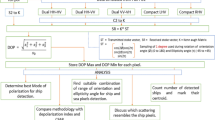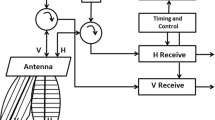Abstract
Remote sensing of vessels is an important tool for ship safety and security at sea. In this work, we are interested in improving ships detection using polarimetric Synthetic Aperture Radar (SAR). To develop the appropriate method, different processing techniques are applied on Pol-SAR images such as fusion and polarimetric decompositions and we use adaptive threshold detectors to assess the performances of the processing techniques. The data exploited in this work were acquired on a port area of the city of Vancouver by using RADARSAT-2 satellite. In this paper it is shown first that when exploiting single polarization, the HH channel provides the highest score of detection probability (PD) of 87.2% for a false alarm probability (PFA) of 0.05%, and this while using the cell averaging constant false alarm rate (CA-CFAR) detector. The result is obtained comparatively with other polarizations (HV, VV) and detection algorithms. Second, the fusion of polarimetric channels achieves its best performances with the CA-CFAR detector, comparatively with the two parameters (2P)-CFAR and generalized likelihood ratio test (GLRT). Third, we find that among the conventional polarimetric techniques, the singular value decomposition (SVD) combined with CA-CFAR detector gives the best results and achieves a detection probability of 91% for a false alarm of 0.05%. This result was obtained by comparing the performances of other combinations of decompositions (Pauli, Freeman, Yamaguchi), fusion and ships detection algorithms. In this paper, we obtain with the proposed approach an increase of 3.8% in detection probability for false alarm probability of 0.05%.








Similar content being viewed by others
Availability of data and material Code
Not applicable.
References
Wackerman, C. C., Friedman, K. S., & Pichel, W. G. (2001). Automatic detection of ships in RADARSAT-1 SAR imagery. Canadian Journal of Remote Sensing, 27(5), 568–577.
Sciotti, M., Pastina, D., & Lombardo, P. (2002). Exploiting the polarimetric information for the detection of ship targets in non-homogeneous SAR images. IEEE International Geoscience and Remote Sensing Symposium (IGARSS'02), 3, 1911–1913.
Touzi, R., Charbonneau, F. J., & Vachon, P. W. (2004). Ship detection and characterization using polarimetric SAR. Canadian Journal of Remote Sensing, 30(3), 552–559.
Nunziata, F., & Migliaccio, M. (2012). Reflection symmetry for polarimetric observation of man-made metallic targets at sea. IEEE Journal of Oceanic Engineering, 37(3), 384–394.
Wang, C., Jiang, S., Zhang, H., & Wu, F. (2014). Ship detection for high-resolution SAR images based on feature analysis. IEEE Geoscience and Remote Sensing Letters, 11(1), 119–123.
Marino, A., Sanjuan-Ferrer, M. J., Hajnsek, I., & Ouchi, K. (2015). Ship detection with spectral analysis of synthetic aperture radar: a comparison of new and well-known algorithms. Remote Sensing, 7, 5416–5439.
Moreira, A., Iraola, P., Younis, M., Krieger, G., Hajnsek, I., & Papathanassiou, K. P. (2013). A tutorial on synthetic aperture radar. IEEE Geoscience and Remote Sensing Magazine. https://doi.org/10.1109/MGRS.2013.2248301
Mahgoun, H., & Ouarzeddine, M. (2016). Volume height estimation based on fusion of discrete fourier transform (DFT) and least square (LS) in a tomographic SAR application. Journal of the Indian Society of Remote Sensing, 45, 217–228.
Mahgoun, H., Ouarzeddine, M., & Chaffa, N.H. (2018). A comparative analysis between a new inversion algorithm MUSIC-LS and the standard MUSIC for volume height estimation in tomography-SAR. The International Conference on Signal, Image, Vision and their Applications-SIVA’18. https://doi.org/10.1109/SIVA.2018.8661142.
Pottier, E., & Ferro-Famil, L. (2013). Tutorial\slides-scattering polarimetry PolSARprov4.2.0. IETR University of Rennes.
Freeman, A., & Durden, S. L. (1993). A three-component scattering model for polarimetric SAR Data. IEEE Transaction on Geoscience and Remote Sensing., 36(3), 963–973.
Yamaguchi, Y., Moriyama, T., Ishido, M., & Yamada, H. (2005). Four-component scattering model for polarimetric SAR image decomposition. IEEE Transactions on Geoscience and Remote Sensing., 43(8), 1699–1706.
Crisp, D.J. (2004). The state of the art in ship detection in synthetic aperture radar imagery. DSTO Information Sciences Laboratory.
Xing, X., & Ji, K. (2011). High resolution SAR imagery ship detection based on Exs-C-CFAR In Alpha Stable Clutters. IGARSS, pp 317–319.
Lervolino, P. (2016). Ship detection with SAR: modelling, designing and real data validation. Ph.D. thesis, University of Surrey.
Qin, X., & Zhou, S. (2013). A CFAR detection algorithm for generalized gamma distributed background in high-resolution SAR images. IEEE Geoscience and Remote Sensing Letters, 10(4), 806–810.
Meyer, F., & Hinzb, S. (2009). Automatic ship detection in space-borne SAR imagery
Pelich, R.M. (2015). Ship detection and characterization from SAR imagery linked with cooperative vessel tracking data, Ph.D. thesis, Bretagne University.
Sciotti, M., Pastina, D., & Lombardo, P. (2001). Polarimetric detectors of extended targets for ship detection in SAR images. IEEE International Geoscience and Remote Sensing Symposium (IGARSS'Ol), 7, 3132–3134.
Espejel-García, D., Ortíz-Anchondo, L. R., Alvarez-Herrera, C., Hernandez-López, A., Espejel-García, V. V., & Villalobos-Aragón, A. (2017). An alternative vehicle counting tool using the kalman filter within MATLAB. Civil Engineering Journal, 3(11), 1029–1035.
Dammalage, T. L. (2018). Effects of site-dependent errors on the accuracy of C/A code DGPS positioning. Civil Engineering Journal, 4(10), 2296–2304.
Razian, S. A., & Mohammadi, H. M. (2017). Optimizing raytracing algorithm using CUDA. Italian Journal of Science and Engineering, 1(3), 167–178.
Veci, L. (2015). SAR Basics Tutorial, SENTINEL-1 Toolbox, Array Systems Computing
MacDonald Dettwiler and Associates. (2016). RADARSAT-2 Product Description, RN-SP-52–1238, II/13.
Author information
Authors and Affiliations
Corresponding author
Ethics declarations
Conflicts of interest
The authors declare that they have no conflict of interest.
Additional information
Publisher's Note
Springer Nature remains neutral with regard to jurisdictional claims in published maps and institutional affiliations.
Rights and permissions
About this article
Cite this article
Mahgoun, H., Chaffa, N.E., Ouarzeddine, M. et al. Application of Polarimetric-SAR Decompositions on RADARSAT-2 Fine Quad-Pol Images to Enhance the Performances of Ships Detection Algorithms. Sens Imaging 21, 56 (2020). https://doi.org/10.1007/s11220-020-00321-3
Received:
Revised:
Accepted:
Published:
DOI: https://doi.org/10.1007/s11220-020-00321-3




